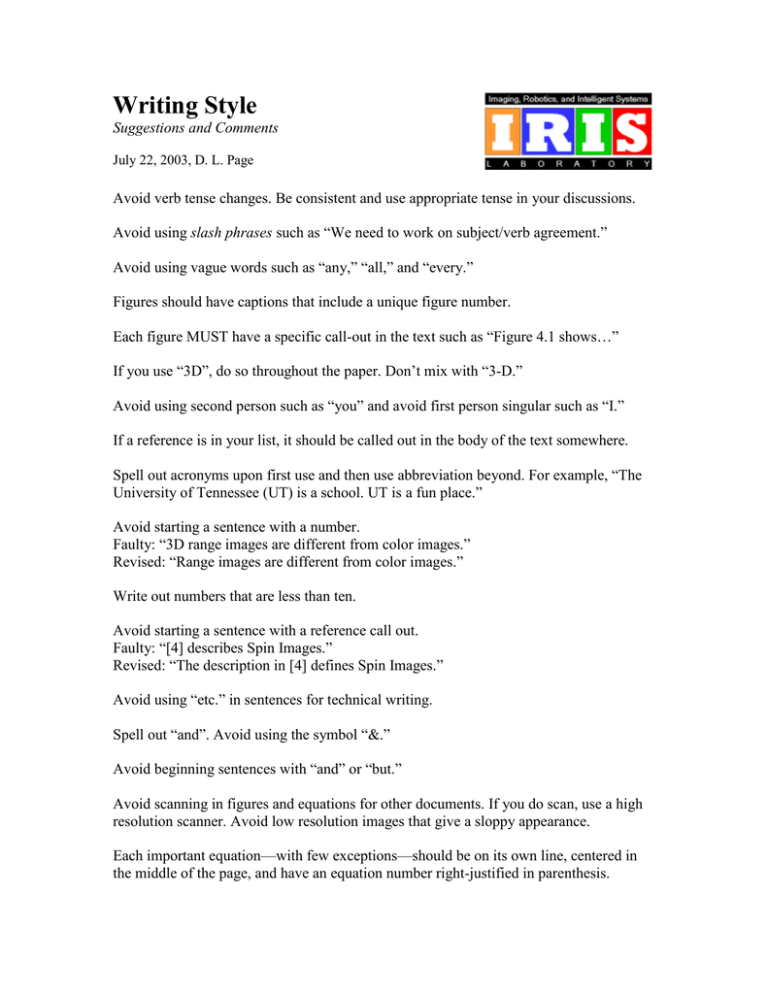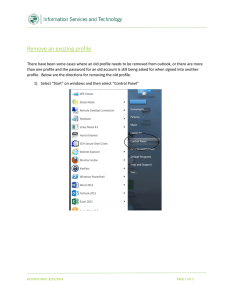Writing Style
advertisement

Writing Style Suggestions and Comments July 22, 2003, D. L. Page Avoid verb tense changes. Be consistent and use appropriate tense in your discussions. Avoid using slash phrases such as “We need to work on subject/verb agreement.” Avoid using vague words such as “any,” “all,” and “every.” Figures should have captions that include a unique figure number. Each figure MUST have a specific call-out in the text such as “Figure 4.1 shows…” If you use “3D”, do so throughout the paper. Don’t mix with “3-D.” Avoid using second person such as “you” and avoid first person singular such as “I.” If a reference is in your list, it should be called out in the body of the text somewhere. Spell out acronyms upon first use and then use abbreviation beyond. For example, “The University of Tennessee (UT) is a school. UT is a fun place.” Avoid starting a sentence with a number. Faulty: “3D range images are different from color images.” Revised: “Range images are different from color images.” Write out numbers that are less than ten. Avoid starting a sentence with a reference call out. Faulty: “[4] describes Spin Images.” Revised: “The description in [4] defines Spin Images.” Avoid using “etc.” in sentences for technical writing. Spell out “and”. Avoid using the symbol “&.” Avoid beginning sentences with “and” or “but.” Avoid scanning in figures and equations for other documents. If you do scan, use a high resolution scanner. Avoid low resolution images that give a sloppy appearance. Each important equation—with few exceptions—should be on its own line, centered in the middle of the page, and have an equation number right-justified in parenthesis. Headings and subheadings stand for divisions, and a division denotes at least two parts. Therefore, to be logical, if one uses a subheading, then you should have a minimum of two subheadings. Also, headings and subheading should have parallel structure Faulty: 1. Introduction of Paper a. Motivation 2. Conclusion Revised: 1. Introduction a. Motivation b. Application 2. Conclusion (faulty parallelism with Conclusions) (faulty division) (revised parallelism to match Conclusions) (revised with two subheadings) For figures and equations in MS Word, use tables extensively, but turn off the table borders. A two-row, one-column table with no borders is perfect for a figure. The top row contains the figure of interest and the bottom row contains the caption. Similarly, a onerow, two-column table with no borders is perfect for an equation. The first column contains the equation and the second column the equation number. For subfigures and multi-line equations, just add the appropriate rows and columns. Examples follow. Figure 1. The latest IVP scanner has a resolution near 5 microns. (a) (b) Figure 2. Range scanners and CMMs are different. (a) IVP range scanner. (b) CMM Probe. E mc 2 (1)

